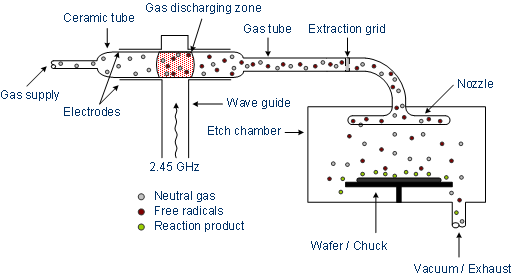The etching characteristic - selectivity, etch profile, etch rate, uniformity, reproducability - can be controlled very precisely in the reactive ion etching (RIE). An isotropic etch profile is possible as well as an anisotropic. Therefore the RIE process, a chemical physical etch process, is the most important process in semiconductor manufacturing for structuring various films.
Inside the process chamber the wafer is placed on a high frequency electrode (HF electrode). By impact ionization a plasma is generated in which free electrons as well as positively charged ions occur. If the HF electrode is at a positive voltage the free electrons accumulate on it and cannot leave the elctrode again because of their electron affinity. Thus the electrode charges up to -1000 V (BIAS voltage). The slow ions which could not follow the fast alternating field are now moving towards the negatively charged electrode.
If the mean free path of the ions is high, the particles impact on the wafer surface in almost perpendicular direction. Thus material is striked out of the surface by the accelerated ions (physical etching), in addition some of the particles are reacting chemically with the surface. Lateral sidewalls are not affected, so that there is no abrasion and the etch profile remains anisotropic. The selectiviy is not too small, however, due to the physical etch progress it's not to large either. In addition the wafer surface is damaged by the accelerated ions and has to be cured by thermal annealing.
The chemical part of the etch process is done by the reaction of free redicals with the surface and also with the physical milled out material in such a way that it can not re-deposit onto the wafer or the chamber walls as in ion beam etching. By increasing the pressure in the etching chamber the mean free path of the particles is reduced. Therefore there are much more collisions and thus the particles are heading into various directions. This causes a less directed etching, the etch process gets a more chemical character. The selectivity increases, the etch profile is more isotropic.
Illustration of a RIE reactor in hexagonal construction
Illustration of a RIE reactor in parallel plate construction
By a passivation of the sidewalls during silicon etching, an anisotropic etch profile is achieved. Thereby oxygen inside the etch chamber reacts with milled out silicon to form silicon dioxide which deposits an vertical sidewalls. An oxide film on horizontal areas is removed due to the ion bombardement so that the etch progress in lateral direction proceeds.
The etch rate depends on the pressure, the power of the HF generator, the process gases, the real gas flow and on the wafer temperature.
The anisotropism increases with increasing HF power, deacresing pressure and decreasing temperature. The uniformity of the etch process depends on the gases, the distance of the two electrodes and on the material the electrodes are made off. If the distance is to small, the plasma cannot be dispersed unfiformly and thus leads to inhomogeneity. If the distance of the electrodes is increased, the etch rate decreases because the plasma is distributed in an enlarged volume. For the electrodes carbon has proven itself as the material of choice. Since fluorine and chlorine gases attack carbon as well, the electrode causes an uniform strained plasma and thus the wafer edge is affected in the same way as the wafer center.
The selectivity and etch rate depend very strong on the process gases. For silicon and silicon compounds fluorine and chlorine gases are used primarily.





